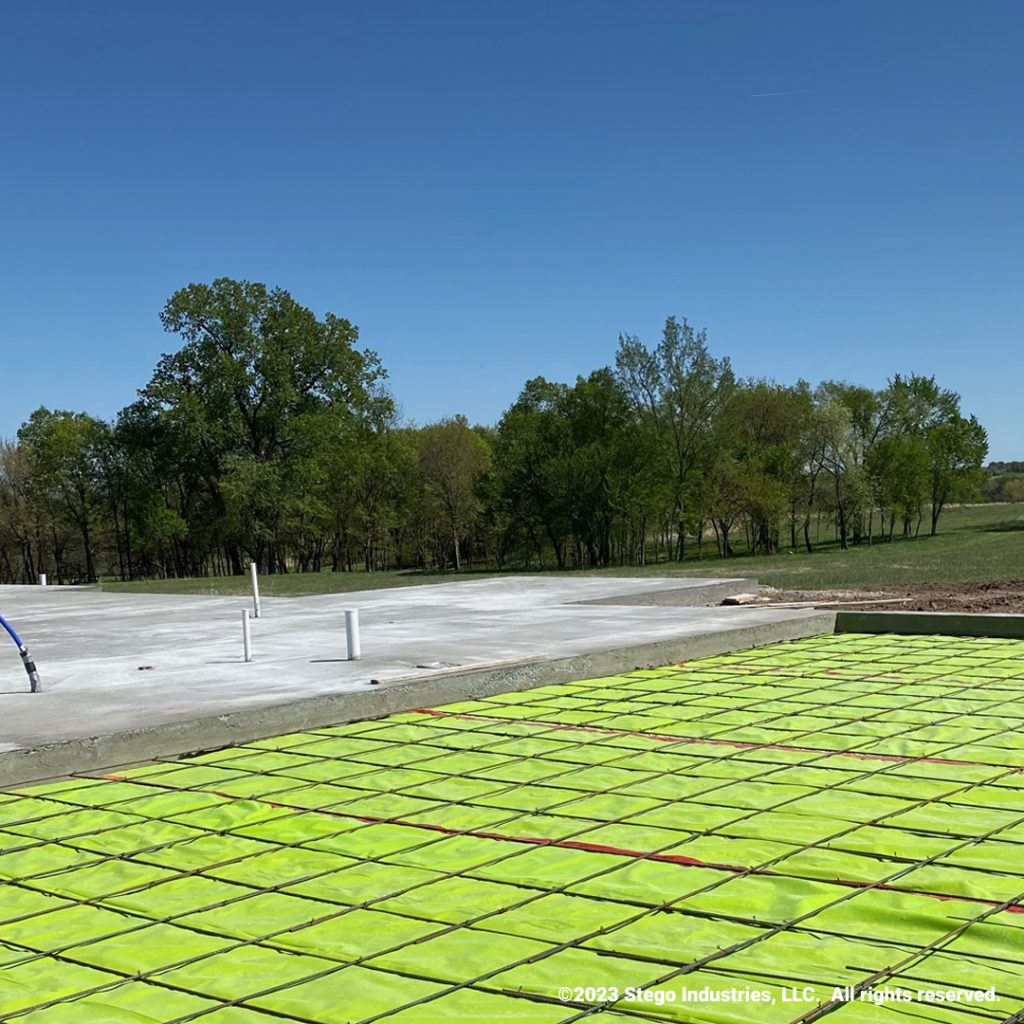Written By: Marco Bacaloni – owner and developer of the Rose Passive House (Ref. 1)
Concrete slabs are fundamental components in various construction projects, ranging from residential homes to commercial buildings and industrial facilities. While concrete is renowned for its strength and durability, it is not impervious to moisture-related issues. A vapor barrier plays a crucial role in concrete slab construction by preventing moisture vapor from migrating from the ground through the slab. This migration can lead to various problems, including moisture-related damage, mold growth, and reduced insulation efficiency.
You might wonder why a vapor barrier is necessary for concrete slabs. The fact that it’s not commonly used doesn’t diminish its importance. Regarding residential construction, in my humble opinion, the limited adoption is primarily due to a lack of awareness of its many benefits and criticality. With nearly 25 years of experience in construction, I’ve encountered numerous residential projects, and I’ve been surprised to find only a few featuring an under-slab vapor barrier.
In my current house, which was built in the ’80s, there’s no vapor barrier beneath the slab. However, for the Rose Passive House project (Ref. 1), which I’ve been preparing for nearly five years, the under-slab vapor barrier is an essential and critical element of the foundation and slab design. I’ve conducted an extensive research on the use of vapor barrier for concrete slab applications, and the following is my list of benefits and reasons why I recommend using an under-slab vapor barrier for all projects, whether they involve new construction or a simple addition:
- Moisture Protection: Vapor barriers are primarily designed to prevent moisture vapor from infiltrating concrete slabs. Moisture infiltration can lead to damage to flooring materials and adhesives installed over the concrete slab, as well as other problems such as cracks, spalling, and even structural damage over time.
- Improved Indoor Air Quality: Moisture that migrates into and potentially through concrete slabs can create an environment conducive to mold and mildew growth. This can significantly increase the risk of respiratory illnesses and conditions, including allergies and asthma. Vapor barriers help inhibit this growth, resulting in improved indoor air quality and a healthier living or working environment.
- Mitigating Radon and Methane Gases: Radon gas, a radioactive and known carcinogen, is one of the primary toxic gases that can migrate from the ground. Additionally, methane is a gas naturally occurring in soil, stemming from the decomposition of organic matter. While methane’s toxicity remains a subject of limited research with conflicting results, it poses a potential risk. An under-slab vapor barrier serves as a protective shield, effectively impeding these gases to reach the slab, so that they can be redirected away from the building.
- Resistance to Chemicals: I have personally witnessed the inconsiderate and reckless release of household products and chemicals into the soil, left behind carelessly during demolition. Similarly, I’ve observed unintentional and inconsiderate spills of gasoline, grease, and oils, essential for operating the equipment used in demolition and grading activities. Vapor barriers are typically made of materials resistant to various chemicals and pollutants commonly found in soil. This resistance serves a dual purpose: safeguarding concrete slabs from chemical deterioration and, most importantly, preventing the infiltration of harmful substances into inhabited spaces.
- Enhanced Durability: By minimizing moisture intrusion, vapor barriers extend the lifespan of concrete slabs and moisture-sensitive flooring, such as hardwood floors. This is especially important in regions with high humidity levels, where moisture-related issues are more prevalent.
- Energy Efficiency: Vapor barriers also contribute to energy efficiency by reducing moisture passage, which helps maintain the insulation properties of the slab and reduces the energy required for heating and cooling.
I believe that one key reason for the limited use of vapor barriers in residential construction is related to how these materials are available on the market. Most leading under-slab vapor barrier manufacturers cater to large commercial projects, offering products in rolls of at least 2000 ft² (180 m²), with some starting at around 3000 ft² (270 m²). Even the few residential contractors interested in slab vapor barriers may be deterred by these large purchases, which can lead to material waste or the need for additional storage. I faced the same dilemma until I discovered StegoHome®.
If you’re involved in the construction industry, you’ve probably heard of or encountered the name “Stego” before. Stego Industries, LLC (Ref. 2) is the industry leader in below-slab vapor barriers in the North American market. Stego Wrap (Ref. 4) is their flagship under-slab vapor barrier product, yellow-colored, offered in rolls measuring 14′ x 140′ (1,960 ft²). StegoHome® (Ref. 3), on the other hand, is their green-colored vapor barrier suitable for smaller residential footprints due to product roll size and weight. Initially, I was skeptical about StegoHome®, assuming it was an inferior product compared to Stego Wrap. However, after closely comparing their specifications, I realized that both products exceeded ASTM E1745 Class A, B, and C standards, had similar water vapor permeance per ASTM F1249 (<0.01 perms for StegoHome®, 0.0086 perms for Stego Wrap), identical Radon Diffusion Coefficients of 8.8 x 10-12 m2/s, and practically the same Puncture Resistance per ASTM D1709 (>2,200 grams for StegoHome® and 2,266 grams for Stego Wrap). From an engineering perspective, they are essentially the same product.

I spoke with Aaron Hill, the Regional Manager for Central California, who confirmed that StegoHome® indeed offers the performance and quality the commercial industry has come to trust with Stego Wrap. The slight differences in material properties are due to variations in the manufacturing process, which is reasonable from a material science standpoint. Aaron also provided me with a valuable article on understanding the ASTM (American Society for Testing and Materials) E1745 Standard (Ref. 5).
The discovery of StegoHome® provided me with peace of mind. I can now use StegoHome® in my projects without worrying about excess material waste or the need for additional storage space, which aligns with my environmental values.
References
- http://passivehouse-losangeles.com/
- https://www.stegoindustries.com
- https://www.stegoindustries.com/products/stego-home-15-mil-vapor-barrier
- https://www.stegoindustries.com/products/vapor-barrier-15-mil
- https://www.stegoindustries.com/blog/astm-e1745-understanding-standard-classifications
- https://www.stegoindustries.com/stegohome-below-slab-vapor-protection-guide

